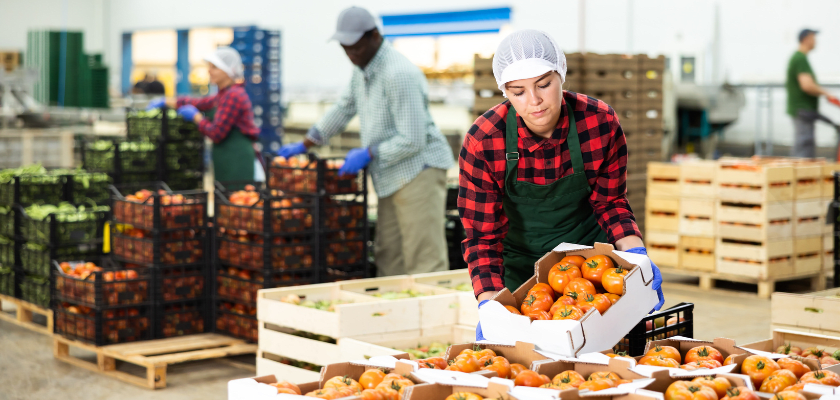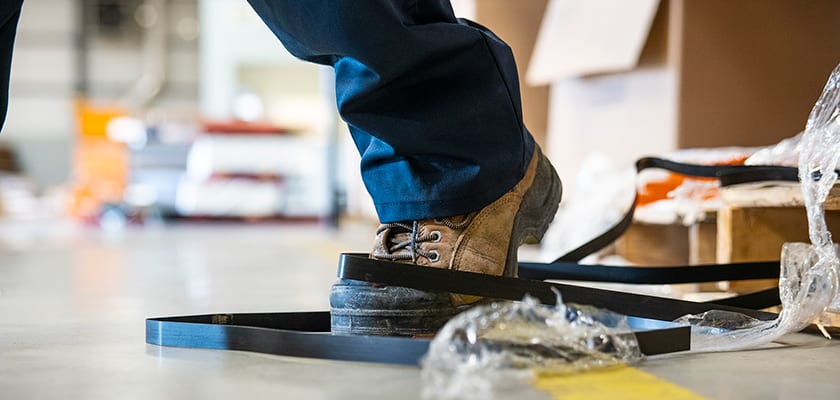Top risks in food and beverage wholesale distribution: Protect your workplace and team with these safety resources

Workplace Safety & Prevention Services (WSPS) is a not-for-profit occupational health and safety association committed to ensuring every worker goes home healthy and safe at the end of the day. As your dedicated health and safety association for the food and beverage wholesale distribution industry, we are here to help with resources and support.
The food and beverage wholesale distribution industry and partners are working with WSPS to develop solutions that address the top risks in this sector. In a recent study, this group identified the top 10 risks in the food and beverage wholesale. Find out what these risks are and how you can protect your business with the resources below.
Top 10 risks in food and beverage wholesale distribution: Resources and training
Click on a hazard to learn more and access health and safety resources and training.
- Musculoskeletal Disorders
- Employee behaviour – low-risk perception
- Slips, Trips and Falls
- Struck Against Racking – head impacts on racking
- Pedestrian Safety (indoor) – struck-by material handling equipment
- Fatigue and Stress
- Temporary Workers – 3rd party agency employees
- Motor Vehicle Incidents – during the transportation of goods
- Moving pallets in and out of racking
- Powered Material Handling Equipment Collisions – with fixed structures/objects
Musculoskeletal Disorders and Manual Material Handling

Manual material handling involves moving materials and goods by carrying, holding, lifting, pulling, pushing, and bending. Repetitive movements, incorrect lifting techniques, fatigue, rushing, and awkward postures can increase the risk of musculoskeletal disorders (MSDs). MSDs are different aches and pains affecting the musculoskeletal system (muscles, tendons, and nerves) and make up almost half of all compensation claims in Ontario. Common MSDs include back pain, carpal tunnel syndrome, and tendonitis. Untreated MSDs can result in lifelong disabilities. Implementing effective controls for manual material handling can reduce these risks and help businesses operate efficiently.
Resources
- Protect your team from the top hazard in food and beverage wholesale distribution: Tips to prevent musculoskeletal disorders (article)
- NEW! MSD Prevention - Hiring & Onboarding Tips for Success (guide)
- NEW! Sample Physical Demands Description - Job: Wholesale Distribution Picker (guide)
- NEW! Palletizing Ergonomics in Food and Beverage Wholesale Distribution (video)
- Safe lifting: 10 tips and videos of how to lift properly (article)
- How to eliminate 3 hidden causes of musculoskeletal disorders (MSDs) (article)
- Back to basics: Answers to your questions about manual material handling and MSDs (article)
- How to identify and prevent repetitive strain injuries (article)
- MLITSD material handling inspections on now: be prepared (article)
- Ergonomics in the workplace: understanding the law (Ontario.ca)
- Safety Tips - Manual Material Handling and Safe Lifting (video series)
- Musculoskeletal Disorders (video)
- MSD Risk Assessment (guide)
- MSD Hazards Checklist
- Business in Motion: Managing Material Handling Hazards (guide)
- Manual Material Handling and Musculoskeletal Disorders (MSDs) Job Aid
- MLITSD Material Handling Inspections - Frequently Asked Questions
- Hand Pallet Trucks and Pump Trucks Job Aid
- Safe Lifting Guides - for workers, employers and supervisors
- Non-motorized Material Handling Equipment Checklist
- Guidelines for Supervisors - Ensuring Safe Lifting and Manual Material Handling in the Workplace Information Guide
- Manual Material Handling - Mobile Ladder Stands or Mobile Ladder Platforms checklist
- Safe Lifting Observer's Checklist
- Ergonomics study for workers at food production industry
Resources from the Centre of Research Expertise for the Prevention of Musculoskeletal Disorders (CRE-MSD)
CRE-MSD conducts research to improve the understanding of and prevention of work-related MSDs. Check out their resources below.
- MSD Prevention Guideline for Ontario
- Ontario Ergonomics Intervention Cost-Benefit Calculator
- Manual Materials Handling (MMH) Solutions to Control MSD Hazards in Manufacturing and Warehousing
- Sample MSD Prevention Policy Statement
- MSD Prevention Program Checklist
- What is a Musculoskeletal Disorder Video
- Quick Start Guides Introduction Video
- Worker Discomfort Survey
Training and consulting
- Safe Lifting & Manual Materials Handling (1/2 day, online instructor-led training)
- Safe Lifting & Manual Materials Handling - Supervisor (1 hour, online instructor-led training)
- Manual Materials Handling (1 hour, eCourse)
- Musculoskeletal Disorders (MSD) Prevention Awareness (1 hour, eCourse)
- Ergonomics Consulting - WSPS experts will work with you and your staff to find personalized, cost-effective solutions to improve your work environment, protect your employees and your bottom line.
Healthy Workplaces and Mental Health
Poor mental health at work can cause physical symptoms like headaches and psychological issues like depression, fatigue, and anxiety. This can lead to more sick days, trouble concentrating, more accidents, and lower productivity. Temporary workers and worker fatigue are common in many businesses. The risk of injuries and incidents rises when workers are tired, new, or unfamiliar with the workplace.
Creating a healthy workplace that includes a positive culture, physical environment, employee well-being, psychological safety, and community involvement is a smart business move. It shows a commitment to workers' well-being, reduces risks and costs, and boosts competitive advantage. Organizations can keep all workers healthy and safe by implementing effective workplace policies and procedures, strong communication and training strategies, and fostering an inclusive environment.
Resources
- 7 workplace strategies for managing employee fatigue (article)
- We're all exhausted. Here's what workplaces can do about it (article)
- Fatigue Fact Sheet (CCOHS Canada)
- Guide for managing the risk of fatigue at work (Safe Work Australia)
- Fatigue impairment (WorkSafe BC)
- Is low risk perception a problem in your workplace? (article)
- New Canadians in your workforce? This manufacturer’s approach can help protect them and you (article)
- 5 tips to protect the health and safety of New Canadians
- Safety Tips: When employing new Canadians, what elements should employers include in orientation/training? (video)
- New temporary help agency licensing requirements: How do they impact your business? (article)
- Leveraging psychological safety to improve worker retention (article)
- Poor Workplace Mental Health is Costing Your Business Money (Trusted Leader Blog)
- How taking vacations can increase productivity and job satisfaction (article)
- Do your managers know how to create a psychologically safe workplace? (article)
- Psychosocial Factors in the Workplace Influence Musculoskeletal Disorders (MSD) and Mental Health (poster)
- Visit the Mental Harm Prevention Roadmap site to create and implement a psychological health and safety strategy at your workplace.
Training and Consulting
- Psychological Health and Safety Awareness (eCourse, 20 minutes)
- Psychological Health and Safety for Workers (eCourse, 1 hour)
- Leading for Psychological Safety in Challenging Times (Online Instructor-Led Training, 1 day)
- Stress in the Workplace (eCourse, 1 hour). Also available in French.
- Workplace Mental Health: How Managers Should Respond (Online Instructor-Led Training, 4 hours)
- Workplace Mental Health: What Health and Safety Committees Should Know (Online Instructor-Led Training, 1 day)
- Reducing Mental Health Stigma in the Workplace (eCourse, 30 minutes)
- Consulting - Connect with WSPS experts to develop a healthy workplace program or a violence, and harassment prevention program.
Mechanical Material Handling and Pedestrian Safety
Mechanical material handling involves transporting, positioning, storing, and manipulating materials within a facility or between different locations using motorized or non-motorized equipment. Key components of these systems include conveyors, lifts, cranes, hoists, and other automated or semiautomated equipment. Mobile equipment like lift trucks and vehicles working near pedestrians can put workers at risk. These risks can lead to serious injuries or death. These incidents can also cause property damage, downtime, and expensive fines for your business.
Reducing the risks of mechanical material handling through control measures improves efficiency, reduces manual labour, minimizes errors, and enhances productivity. Controlling workplace traffic-related hazards mitigates the potential harm to pedestrians in warehouse environments. An organized warehouse, with a defined traffic flow, also encourages productivity and has a positive bottom-line impact.
Resources
- 8 steps to keep lift truck operators and pedestrians safe (article)
- 6 steps to implement a traffic management plan (article)
- Warehouses - Traffic Management & Pedestrian Safety (pre-recorded webinar)
- Worker resources: Safety around forklifts, cars, vans and trucks (video or article)
- Guide to workplace traffic management (Safe Work Australia)
- Safety in 60 Seconds: What are the fundamentals of a strong traffic management assessment and program? (video)
- Vehicle & Pedestrian Safety (video)
- Mechanical Material Handling Q&A: Your questions answered (article)
- Protect warehouse workers from struck-by incidents: Real life examples and expert tips (article)
- Prevent struck-by incidents: 3 expert tips to keep workers safe (article)
- 8 tips for managing external traffic
- Nip point incident offers 6 lessons for workplaces (article)
- Updated CSA guideline provides step by step process for effective rack inspections (article)
- Inspecting robot systems: 7 ways to boost JHSC performance (article)
- Worker Resource: Loading and Unloading Trailers Safely (article and video)
- Safety in 60 Seconds: Safety tips - What should employees know about loading and unloading a truck or trailer safely? (video)
- Warehouse Safety Tips - Assess Your Warehouse Risks (video)
- Loading Docks and Warehouses (guide)
Safety Checklists
- Working Around Traffic
- Visibility Hazards Checklist
- Reach Truck/Order Picker Safety
- Storage Rack Safety
- Forklift Job Aid
Training and Consulting
- Contact WSPS for training options including forklift safety, overhead and mobile crane training and more.
- Consulting - Our warehousing consultants can help you identify and assess hazards and develop a traffic management and pedestrian safety system tailored to your workplace. Connect with a consultant.
Slips, Trips and Falls

Slips, trips, and falls are common workplace injuries. A good housekeeping program, including quick spill clean-ups, can help reduce the risk of injury. Injuries caused by slips, trips and falls are a leading cause of missed time at work and can occur at any workplace. Effective work plans, policies and programs should be developed collaboratively with workers to ensure ladders, fixed and portable anchoring points for structures, machinery and other platforms are in place and inspected regularly, through a preventive maintenance program.
Resources
- Stop slips, trips and falls with these expert tips (article)
- Falls from under 3-metres can be fatal: how to prevent them (article)
- Slips, Trips, and Falls Overview (article)
- Safety Check: Mopping Spills Safety (guide)
- Safety Check: Step Ladder Safety (guide)
- Mobile Ladder Stands or Mobile Ladder Platforms (guide)
- Job Aid - Working at Heights
- Working at Heights Regulation and Information (article)
- Housekeeping / Preventative Maintainence Overview (article)
- Overview: Working at Heights Regulation and Information
- Preventing slips, trips, and falls in the workplace (Ministry of Labour, Immigration, Training and Skills Development)
- Preventing Slips, Trips, and Falls in the Workplace (WorkSafe BC)
Training
- Preventing Falls from Slips and Trips (1 hour self-paced eCourse)
- Ladder Safety Training (1 hour self-paced eCourse)
- Working at Heights (an Introduction) (1 hour, self-paced eCourse)
Connect with an expert
If you’re ready to get started, or simply have questions about our services or approach, contact a WSPS specialist to find out more.






